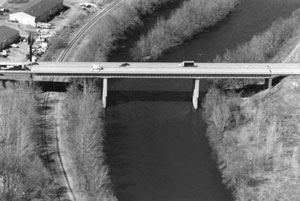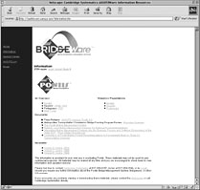U.S. Department of Transportation
Federal Highway Administration
1200 New Jersey Avenue, SE
Washington, DC 20590
202-366-4000
Focus
| Accelerating Infrastructure Innovations |
Publication Number: FHWA-RD-02-012
Date: July 2002
Pontis, the bridge management system of choice for a growing number of States, is now better than ever with the release of Version 4.1. The software can assist highway agencies in organizing their bridge data and analyzing complex engineering and economic factors to make smart decisions about maintaining, improving, and replacing structures. It also allows States to look into the future and show those making funding decisions how much needs to be invested in bridges to minimize the long-term preservation costs and the consequences of different investment levels on bridge condition and performance.
The Pontis system's database can store a complete bridge inventory and bridge condition history, as well as project development and tracking information. The new version of Pontis builds on the project planning capabilities of Pontis 4.0 by integrating its database with two other bridge software programs, Virtis and Opis. Virtis is a load rating program that determines what loads a bridge can handle. Opis is a design program that can perform analysis and specification checking on a variety of bridge types, including steel, reinforced concrete, and prestressed concrete. All three programs are part of the American Association of State Highway and Transportation Officials' (AASHTO) BRIDGEWare line of software.
The new integration capabilities of Pontis, Virtis, and Opis mean that BRIDGEWare users can maintain one bridge database, with the software systems sharing their common bridge information automatically. "Sharing the database information is a great asset. You do less work," says José Aldayuz of AASHTO. "There's no lag in information updates. This real time inventorying means that there's less possibility for error," he adds.
Another benefit is that all three software products undergo the same testing process. In addition, strategic plans for the products are being aligned so that they are in sync. "We're looking at where we want to go in the future with these products, in order to benefit States the most," says Aldayuz. Possible updates being looked at include adding Web-enabled transactions for data entry and more flexible reporting capabilities.
 |
| Pontist can assist highway agencies in organizing and analyzing their bridge data. |
 The Montana Department of Transportation (DOT) uses Pontis to establish performance standards and determine what additional structures projects should be done on top of those already scheduled. "Pontis also helps us to develop a list of proposed maintenance over time," says Paul Jensen of Montana DOT and a member of the AASHTO BRIDGEWare Task Force. "It is helping us attain more consistent management of our bridges. We're smoothing out the peaks and valleys." Montana uses Pontis in conjunction with Virtis and Opis. "We have one central location for all of our data now, whether we are rating structures or doing appraisals. The programs can recalculate data for all of our needs," says Jensen.
The Montana Department of Transportation (DOT) uses Pontis to establish performance standards and determine what additional structures projects should be done on top of those already scheduled. "Pontis also helps us to develop a list of proposed maintenance over time," says Paul Jensen of Montana DOT and a member of the AASHTO BRIDGEWare Task Force. "It is helping us attain more consistent management of our bridges. We're smoothing out the peaks and valleys." Montana uses Pontis in conjunction with Virtis and Opis. "We have one central location for all of our data now, whether we are rating structures or doing appraisals. The programs can recalculate data for all of our needs," says Jensen.
The California Department of Transportation (Caltrans) started using Pontis in 1992. "At that time it was revolutionary. There was no such thing as a bridge management system," says Michael Johnson of Caltrans. With Caltrans responsible for 25,000 bridges in the State, Pontis allows the agency to keep all the data in one database. "Pontis forms the core of our database. We routinely use it for budgeting and to assist with our 10-year preservation plan. It's the only real tool we have to look into the future," says Johnson.
California also used Pontis to analyze six different designs that were being considered for the replacement of a bridge over the Carquinez Straits. Pontis calculated the expected annual maintenance costs for each design. These maintenance cost comparisons were combined with initial construction cost estimates to produce life-cycle cost estimates for consideration in the final design selection. "This software has practical applications that have yet to be discovered. You just have to think a little outside the box and your bridge data can work for you," says Johnson.
For more information on Pontis 4.1, Virtis, or Opis, contact José Aldayuz at AASHTO, 202-624-3610 (fax: 202-624-5469; email: jaldayuz@aashto.org). You can also contact the Pontis Support Center at 617-354-0167 (fax: 617-354-1542; email: pontis@camsys.com; Web: aashtoware.camsys.com) or visit the Virtis/Opis Support Web site at aashto.bakerprojects.com/virtis/. To obtain a license for use of the software, contact Angelique Williams, AASHTOWare Business Manager, at 202-624-5808 (email: angelw@aashto.org).
| A Pontis User Training Meeting will be held September 27-28, 2002, in Phoenix, Arizona. The goal of the meeting is to help highway agencies get more out of using Pontis and to explore the future direction of the bridge management tool. The event is being hosted by the City of Phoenix and the Arizona DOT. For more information, contact Michael Ziegler of the City of Phoenix at 602-534-0966 (email: michael.ziegler@phoenix.gov). |
| Learn more about Pontis at a new National Highway Institute (NHI) course, Pontis Bridge Management (Course No. 130080). FHWA's Office of Asset Management coordinated the development of the course in partnership with AASHTO. "It was very important that the FHWA Resource Centers be a major player in the course development," says George Romack of FHWA. "They have done so by providing financial support and allowing the bridge management engineer in each center to serve as instructors for the course." The pilot for the course was held in May, with the first two regular sessions scheduled for July in Trenton, New Jersey, and Dover, Delaware. A session is also being planned for Salt Lake City, Utah, in August. The 2 1/2-day course offers a hands-on learning experience. Participants will use the Pontis database and the program's analysis tools to develop goals, strategies, and projects. Participants will also learn about performance measures and how the program's reporting capabilities can be used to define goals and track results. The software's project planning module will be extensively covered. This module was completely redesigned for Pontis 4.0, as prior versions of the program had contained only limited project details. In addition to the 2 1/2-day training, a 2-hour session has been developed to serve as an introduction to the attributes and benefits of the Pontis program. This introduction is designed for State and local government executives and upper- and mid-level professionals responsible for an agency's bridge or highway program. For more information about the NHI course, contact George Romack at FHWA, 202-366-4606 (email: george.romack@fhwa.dot.gov). To schedule the course, contact Danielle Mathis-Lee at NHI, 703-235-0528 (email: danielle.mathis-lee@fhwa.dot.gov) or the following Resource Center bridge management specialists:
|